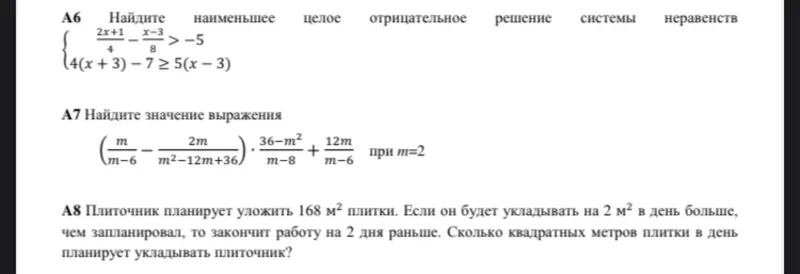I'll solve these algebra problems step by step.
Find the smallest negative integer solution to the system of inequalities:
\[
\left\{\begin{array}{c}
\frac{2 x+1}{4}-\frac{x-3}{8}>-5 \\
4(x+3)-7 \geq 5(x-3)
\end{array}\right.
\]
Simplify the first inequality
Let's start with the first inequality:
\[\frac{2x+1}{4}-\frac{x-3}{8}>-5\]
Finding a common denominator of 8:
\[\frac{2(2x+1)}{8}-\frac{x-3}{8}>-5\]
\[\frac{4x+2}{8}-\frac{x-3}{8}>-5\]
\[\frac{4x+2-(x-3)}{8}>-5\]
\[\frac{4x+2-x+3}{8}>-5\]
\[\frac{3x+5}{8}>-5\]
Multiply both sides by 8:
\[3x+5>-40\]
\[3x>-45\]
\[x>-15\]
Simplify the second inequality
Now let's work on the second inequality:
\[4(x+3)-7 \geq 5(x-3)\]
Expand:
\[4x+12-7 \geq 5x-15\]
\[4x+5 \geq 5x-15\]
\[4x-5x \geq -15-5\]
\[-x \geq -20\]
\[x \leq 20\]
Find the solution to the system
Combining our results:
\[x > -15\] and \[x \leq 20\]
This gives us the solution set: \[-15 < x \leq 20\]
Since we need the smallest negative integer solution, we need the smallest integer greater than -15, which is -14.
\[\boxed{-14}\]
Find the value of the expression
\[
\left(\frac{m}{m-6}-\frac{2 m}{m^{2}-12 m+36}\right) \cdot \frac{36-m^{2}}{m-8}+\frac{12 m}{m-6} \quad \text { at } m=2
\]
Simplify the first fraction
Let's first note that \(m^2-12m+36 = (m-6)^2\), which will help simplify the expression.
\[\frac{m}{m-6}-\frac{2 m}{m^{2}-12 m+36} = \frac{m}{m-6}-\frac{2 m}{(m-6)^2}\]
Let's find a common denominator:
\[\frac{m(m-6)}{(m-6)(m-6)}-\frac{2 m}{(m-6)^2} = \frac{m(m-6)-2m}{(m-6)^2}\]
\[= \frac{m^2-6m-2m}{(m-6)^2} = \frac{m^2-8m}{(m-6)^2}\]
Simplify the entire expression
Now let's look at the full expression:
\[\left(\frac{m^2-8m}{(m-6)^2}\right) \cdot \frac{36-m^{2}}{m-8}+\frac{12 m}{m-6}\]
Note that \(36-m^2 = -(m^2-36) = -(m-6)(m+6)\)
So we have:
\[\left(\frac{m^2-8m}{(m-6)^2}\right) \cdot \frac{-(m-6)(m+6)}{m-8}+\frac{12 m}{m-6}\]
Simplifying:
\[\frac{-(m^2-8m)(m-6)(m+6)}{(m-6)^2(m-8)}+\frac{12 m}{m-6}\]
\[= \frac{-(m^2-8m)(m+6)}{(m-6)(m-8)}+\frac{12 m}{m-6}\]
Evaluate at m = 2
Now we substitute m = 2:
\[\frac{-(2^2-8\cdot2)(2+6)}{(2-6)(2-8)}+\frac{12 \cdot 2}{2-6}\]
\[= \frac{-(4-16)(8)}{(-4)(-6)}+\frac{24}{-4}\]
\[= \frac{-(-12)(8)}{24}+\frac{24}{-4}\]
\[= \frac{96}{24}-\frac{24}{4}\]
\[= 4-6\]
\[= -2\]
\[\boxed{-2}\]
A tile layer plans to lay 168 m² of tiles. If he lays 2 m² more per day than planned, he will finish the job 2 days earlier. How many square meters of tiles per day does the tile layer plan to lay?
Set up the variables
Let's define:
- x = the number of square meters the tile layer plans to lay per day
- n = the number of days originally planned
Since the total area is 168 m², we have:
\[x \cdot n = 168\]
\[n = \frac{168}{x}\]
If he lays (x + 2) m² per day, he will finish in fewer days. Let's call this new number of days (n - 2):
\[(x + 2)(n - 2) = 168\]
Create and solve the equation
We know that:
\[(x + 2)(n - 2) = 168\]
Substituting \(n = \frac{168}{x}\):
\[(x + 2)(\frac{168}{x} - 2) = 168\]
Expand:
\[(x + 2)(\frac{168 - 2x}{x}) = 168\]
\[\frac{(x + 2)(168 - 2x)}{x} = 168\]
\[\frac{168x + 336 - 2x^2 - 4x}{x} = 168\]
\[\frac{-2x^2 + 164x + 336}{x} = 168\]
\[-2x^2 + 164x + 336 = 168x\]
\[-2x^2 + 164x - 168x + 336 = 0\]
\[-2x^2 - 4x + 336 = 0\]
\[x^2 + 2x - 168 = 0\]
Solve the quadratic equation
Using the quadratic formula:
\[x = \frac{-2 \pm \sqrt{4 + 4 \cdot 168}}{2} = \frac{-2 \pm \sqrt{676}}{2} = \frac{-2 \pm 26}{2}\]
This gives us:
\[x = \frac{-2 + 26}{2} = 12\] or \[x = \frac{-2 - 26}{2} = -14\]
Since we're talking about area, x must be positive, so x = 12.
Let's verify: If x = 12, then n = 168/12 = 14 days.
If he lays 14 m² per day, he would finish in (168/14) = 12 days, which is 2 days earlier.
\[\boxed{12 \text{ m}^2}\]
A6: \[\boxed{-14}\]
A7: \[\boxed{-2}\]
A8: \[\boxed{12 \text{ m}^2}\]






